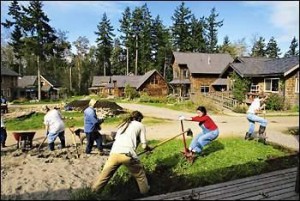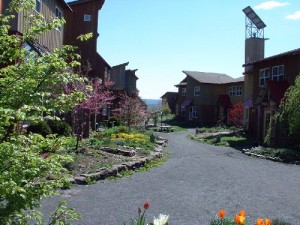Cohousing is a type of collaborative housing in which residents actively participate in the design and operation of their own neighborhoods.
Cohousing residents are consciously committed to living as a community. The physical design encourages both social contact and individual space. Private homes contain all the features of conventional homes, but residents also have access to common facilities such as open space, courtyards, a playground and a common house.
Old-fashioned sense of neighborhood
Cohousing communities are usually designed as attached or single-family homes along one or more pedestrian streets or clustered around a courtyard. They range in size from 7 to 67 residences, the majority of them housing 20 to 40 households. Regardless of the size of the community, there are many opportunities for casual meetings between neighbors, as well as for deliberate gatherings such as celebrations, clubs and business meetings.
The common house is the social center of a community, with a large dining room and kitchen, lounge, recreational facilities, children’s spaces, and frequently a guest room, workshop and laundry room. Communities usually serve optional group meals in the common house at least two or three times a week.
The need for community members to take care of common property builds a sense of working together, trust and support. Because neighbors hold a commitment to a relationship with one another, almost all cohousing communities use consensus as the basis for group decision-making.
What makes cohousing communities unique
The cohousing idea originated in Denmark, and was promoted in the U.S. by architects Kathryn McCamant and Charles Durrett in the early 1980s. The Danish concept of “living community” has spread quickly. Worldwide, there are now hundreds of cohousing communities, expanding from Denmark into the U.S, Canada, Australia, Sweden, New Zealand, the Netherlands, Germany, France, Belgium, Austria and elsewhere.
In a cohousing community, you know who lives six houses down because you eat common meals with them, decide how to allocate homeowners dues and gratefully accept a ride from them when your car’s in the shop. You begin to trust them enough to leave your 4-year-old with them. You listen to what they have to say, even if you don’t agree with them at first, and you sense that you, too, are being heard.

A work-party at Vashon Cohousing, near Seattle, coming together to create a garden for their village.
Cohousing residents generally aspire to “improve the world, one neighborhood at a time.” This desire to make a difference often becomes a stated mission, as the websites of many communities demonstrate. For example, at Sunward Cohousing near Ann Arbor, MI, the goal is to create a place “where lives are simplified, the earth is respected, diversity is welcomed, children play together in safety, and living in community with neighbors comes naturally.” At Winslow Cohousing near Seattle, the aim is to have “a minimal impact on the earth and create a place in which all residents are equally valued as part of the community.” At EcoVillage at Ithaca, NY, the site of two adjoining cohousing neighborhoods, the goal is “to explore and model innovative approaches to ecological and social sustainability.”
Many other communities have visions that focus specifically on the value of building community. Sonora Cohousing in Tucson, AZ, seeks “a diversity of backgrounds, ages and opinions, with our one shared value being the commitment to working out our problems and finding consensus solutions that satisfy all members.” Tierra Nueva Cohousing in Oceano, CA, exists “because each of us desires a greater sense of community, as well as strong interaction with and support from our neighbors.”
The content on this page is sourced, with permission, from “What is Cohousing?” of:




Connect with us